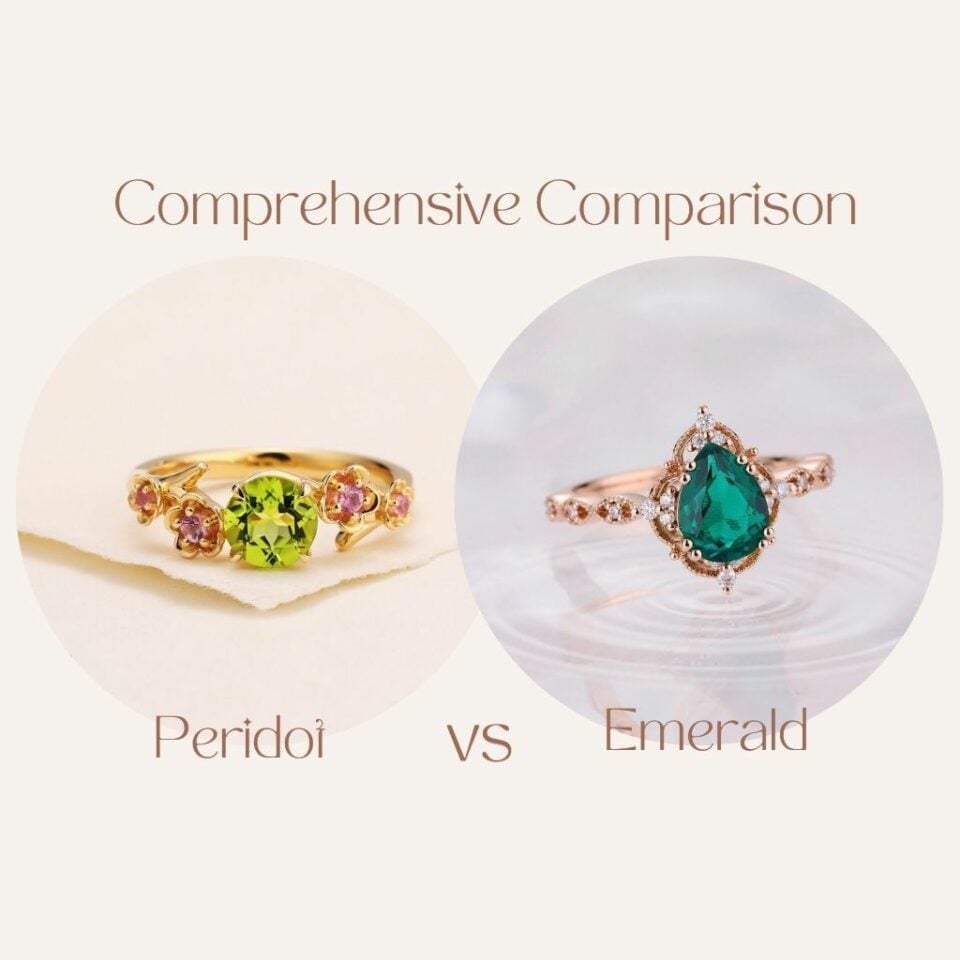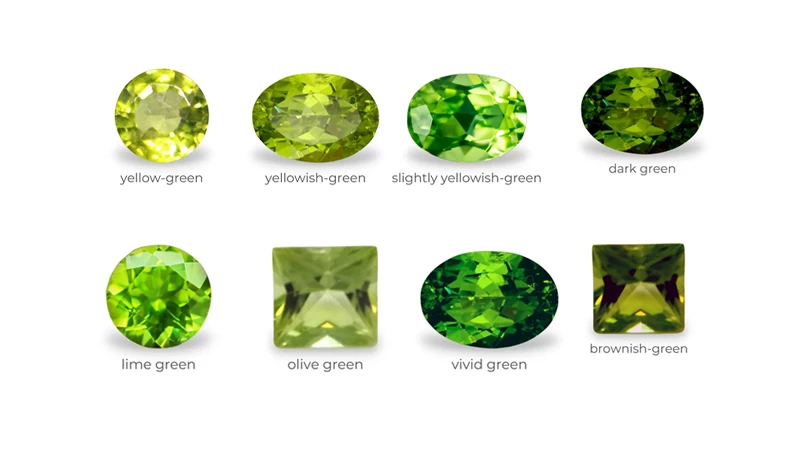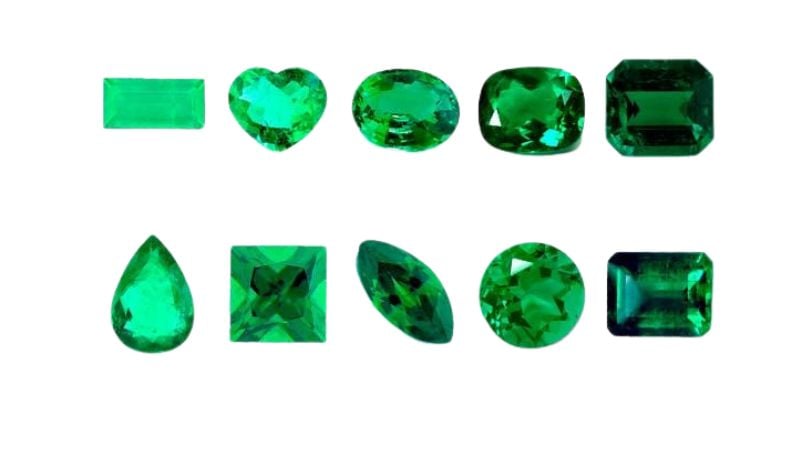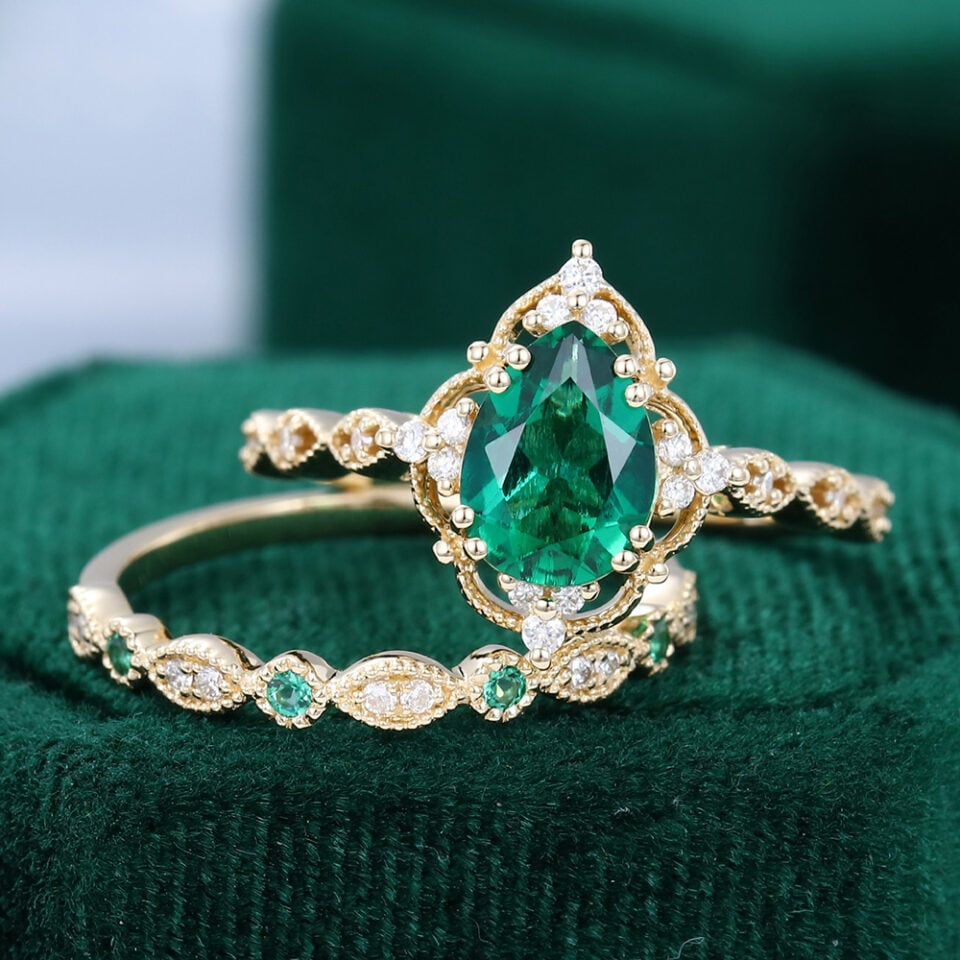If you were asked to name two green gemstones, how would you answer? The first two that come to my mind are emerald and peridot. They are both very popular green gemstones—one being the “king of green gemstones” (emerald), and the other the most popular green semi-precious stone (with everything besides diamond, ruby, emerald, and sapphire being classified as semi-precious). So, if you had to choose between peridot and emerald, which would you pick? If you’re still unsure, don’t rush to answer. In this article, we will provide a comprehensive comparison of these two gemstones to help you make a more informed decision.

Table Of Contents
- Peridot vs. Emerald In Origins
- Peridot vs. Emerald In Color
- Peridot vs. Emerald In Durability
- Peridot vs. Emerald In Clarity
- Peridot vs. Emerald In Cut
- Peridot vs. Emerald In Rarity
- Peridot vs. Emerald In Affordability
- Peridot vs. Emerald In Symbolism
- How to Choose Between Peridot and Emerald?
- Final Thoughts
- Common Questions about Peridot vs. Emerald
| Types | Peridot | Emerald |
|---|---|---|
| Chemical Formula | (Mg, Fe)₂SiO₄ | Be₃Al₂(SiO₃)₆ |
| Formation | Mantle, volcanic eruptions | Earth’s crust thermal flow |
| Main Source | Arizona, USA | Colombia |
| Color | Yellow-green hues | Blue-green hues |
| Hardness | 6-7 | 7.5-8 |
| Clarity | Fewer inclusions | Usually contains inclusions (“le jardín”) |
| Best Cut | Brilliant round cut | Emerald cut |
| Rarity | More abundant | Very rare |
| Price | Lower | Higher |
| Birthstone for Month | August | May |
| Anniversary Gemstone | 15th anniversary | 20th and 35th anniversary |
Peridot vs. Emerald In Origins
Peridot: Peridot is found in many locations, with Arizona, USA, being the most prominent source. It forms deep in the mantle and is brought to the surface by geological activities like volcanic eruptions. Some peridots even come from outer space, as part of meteorites.
Extra information on outer space origins: In the 18th century, German naturalist Peter Simon Pallas discovered peridot inclusions in meteorites. In 2003, NASA’s Mars Global Surveyor found that over 19,000 miles of Mars are covered with peridot, giving the red planet an undeniable greenish hue. On May 15, 2019, the top international academic journal Nature published an article titled “Chang’E-4 initial spectroscopic identification of lunar far-side mantle-derived materials,” indicating that the moon’s mantle is rich in peridot.
Emerald: Emeralds are primarily sourced from Zambia, Madagascar, Colombia, Canada, and other locations. They form in metamorphic rocks, especially those containing beryllium, under high temperature and high-pressure conditions, where beryllium combines with other elements to create emeralds.
Peridot vs. Emerald In Color
Color is something we notice at first glance. While both peridot and emerald are green gemstones, they have distinctly different shades of green. Please refer to Image 1 (peridot’s color) and Image 2 (emerald’s color).

Peridot: As seen in the image, peridot is a bright olive green with yellowish undertones, giving it a fresh feel. The saturation of peridot’s green is influenced by the iron content in its chemical makeup—the higher the iron content, the deeper the green. Additionally, high temperatures (between 900℃-1500℃) are often used to enhance the green saturation of peridot, and this enhancement is permanent.

Emerald: The emerald’s green, as seen in the image, is a richer, deeper green with bluish hues, giving it a more elegant and noble appearance. These hues are produced by the chromium and vanadium in their chemical composition.
An Interesting Knowledge: Did you know? The 200-carat green gemstone in the Three Holy Kings Shrine at Cologne Cathedral in Germany is actually a peridot.
Peridot vs. Emerald In Durability
Hardness is one of the criteria used to assess the durability of gemstones. The harder the gemstone, the more durable it is.
Peridot: Peridot has a Mohs hardness of 6.5-7, which places it in the upper middle range of hardness. This indicates that while it isn’t extremely hard and durable, it is not too fragile for wear. If you intend to wear this gemstone for an extended period, regular and proper maintenance is needed. Additionally, you may want to consider the gemstone setting style when purchasing, as some settings offer better protection for the gemstone, such as bezel settings.
Emerald: Emerald has a hardness of 7.5-8, which is higher than that of peridot, making it suitable for everyday wear. However, you should still avoid impacts that could damage the gemstone. Emeralds are often used in jewelry intended for long-term wear, such as emerald engagement rings and wedding rings, which are very popular in bridal jewelry.
Peridot vs. Emerald In Clarity
Clarity is a significant factor that affects both the appearance and value of a gemstone.
Peridot: Most peridots contain tiny black chromite crystals as inclusions, which are the “fingerprints” of peridot and its natural hallmark. Eye-clean peridots are relatively common, and their clarity is graded internationally into five levels: FI (flawless), LI (light inclusions), MI (moderate inclusions), HI (heavy inclusions), and EI (extreme inclusions).
Emerald: Unlike peridot, even high-quality emeralds often contain inclusions, which is a characteristic of beryl minerals (which have fractures). Inclusions in emeralds are normal and are referred to as “le jardin,” meaning “the garden,” which adds to their charm. Emeralds do not have as strict clarity grading standards as diamonds. They are usually graded into three categories: EC1-EC2 (eye-clean), VI1-VI2 (slightly included, “eye-visible light inclusions”), and I1-I2 (included, “obvious inclusions”).
The industry commonly performs clarity enhancement treatments on emeralds with inclusions. This practice is widely accepted, with the enhancement process involving introducing fillers into the fractures of emeralds under a vacuum to “clear” the fractures, thereby improving clarity. Common fillers include oils, synthetic resins, and wax, with oil being the most recognized enhancement (note: this enhancement is only semi-permanent). Therefore, GIA has also labeled these treated emeralds with enhancement grades: None (no oil, “untreated”), F1 (minor oil, “light enhancement”), F2 (moderate oil, “moderate enhancement”), and F3 (heavy oil, “significant enhancement”).
Peridot vs. Emerald In Cut
Peridot: Peridot does not require any special cutting considerations. The primary purpose of cutting peridot is to maximize the gemstone’s brilliance and fire. Therefore, the most suitable cut for peridot is the brilliant round cut. Of course, if you prefer other cuts, such as oval, cushion, or pear-shaped, those are also possible. When purchasing, it is important to pay close attention to the quality of the jeweler’s cutting, as good craftsmanship can better showcase the gemstone’s sparkle.
Emerald: Due to the higher number of inclusions in emeralds, they are often cut using a step cut. This cutting style not only preserves the gemstone’s weight but also disperses light to minimize the visibility of flaws and deepen the gemstone’s color, making the green richer. The emerald cut is the most compatible with emeralds and was originally designed specifically for this gemstone, perfectly showcasing emerald’s unique allure.
Peridot vs. Emerald In Rarity
Peridot: Peridot is widely distributed across the globe and can be found in almost every country, so its supply is relatively abundant. Have you heard of Papakolea Beach? In June 2018, the eruption of the Kīlauea volcano in the Hawaiian Islands made the beach almost entirely composed of peridot. That’s why there’s a funny saying in the region, “Any stone you pick up is a peridot.”
Emerald: As one of the four precious gemstones, the rarity of emeralds is not hard to see. The first emerald mine was discovered as early as 4000 BC, and due to its long history, the resources have been exhausted prematurely. Additionally, emerald formation requires specific geological conditions, and places that meet these conditions are relatively few, making emeralds extremely rare.
Peridot vs. Emerald In Affordability
Peridot: Peridot is more affordable due to its higher supply compared to emerald.
Emerald: Emeralds have strict formation conditions, are limited in distribution, and have a smaller supply, making them more expensive.
Generally, the price of a 1-carat peridot of average quality may range from hundreds to thousands of yuan. In contrast, a 1-carat emerald of average quality would start at a few thousand dollars. If you’re looking for a high-quality emerald at affordable prices, consider purchasing a lab emerald. Lab-grown gemstones share the same properties as natural ones and offer controlled quality, making them an increasingly embraced lower-risk choice.
Related Reading: Most Popular Lab Gemstone Rings
Peridot vs. Emerald In Symbolism
Peridot: Peridot was called the “gem of the sun” by ancient Egyptians, symbolizing the sun’s light and warmth, health, and vitality. It is believed to bring happiness, peace, and tranquility, as well as promote physical recovery. Additionally, peridot is the birthstone for August and the gemstone for the 16th wedding anniversary.
Emerald: Emerald is believed to be the gemstone of the goddess Venus, symbolizing love, loyalty, eternity, luck, wisdom, growth, and rebirth. It is thought to bring love, wealth, and success. Additionally, emerald is the birthstone for May and the gemstone for the 20th and 35th wedding anniversaries.
How to Choose Between Peridot and Emerald?
Budget: Peridot is relatively affordable, while emerald is rarer and more expensive. Therefore, if you have a limited budget, consider Peridot. Otherwise, emerald is the more luxurious choice.
Occasion: If you plan to wear the gemstone every day, emerald is the better choice as it is more durable. For casual or special occasions, peridot can be worn.
Visual appeal: Peridot is a bright yellow-green color with a fresh and lively feel, while emerald is a rich, deep green with bluish undertones, giving it a more elegant and noble appearance. Choose according to your personal preference.
Sentimental value: If you’re born in May, emerald is your birthstone, and if you’re born in August, peridot is your birthstone. You can choose according to your birth month. Also, if you are celebrating your 16th anniversary, you can choose peridot, and for your 20th or 35th anniversary, you can choose emerald.
Final Thoughts
Peridot and emerald are both beautiful and popular green gemstones, but they have two distinctly different characteristics. We hope that understanding these differences will help you make a better choice. If you’re looking for stunning peridot or emerald jewelry, be sure to visit MollyJewelryUS, where you’ll find high-quality peridot jewelry and affordable lab-grown emerald jewelry.
Common Questions about Peridot vs. Emerald
Which is cheaper, emerald vs. peridot?
Peridot is more affordable due to its higher availability.
Is emerald more durable than peridot?
Yes, emerald is more durable because it has a higher hardness than peridot.
Which is greener, peridot vs. emerald?
Both gemstones have different shades of green; peridot tends to have a yellow-green hue, while emerald is known for its blue-green hues.
Which is better for everyday wear, peridot vs. emerald?
Emerald is generally more suitable for everyday wear due to its higher hardness. However, peridot can also be worn daily with proper care and protective settings.
Which is more popular, peridot vs. emerald?
Historically, emerald has been the most popular green gemstone, while peridot has not had as much historical popularity. However, peridot is the most popular green gemstone among semi-precious stones.
Which is better for an engagement ring, peridot vs. emerald?
Emerald is the traditional choice for engagement rings due to its durability and suitability for long-term wear, making it a better option. However, the beauty of peridot has also made it a popular choice for some.



